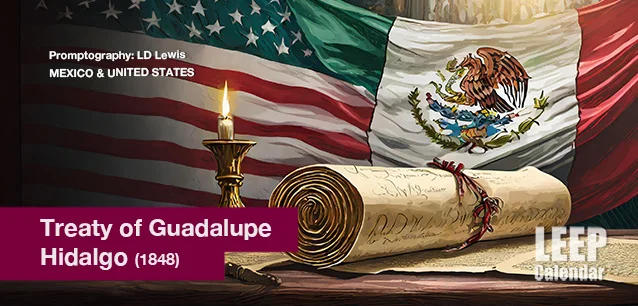 AD
AD
Today is: August 04
Scroll to explore events active on this date.
LEEP INK FEATURES

May Blooms: Events in May 2025
Along with October, May is one of the most densely packed months of the year. It's before the summer humidity and the last whole month of the school year. The weather is warming in t...

Sweet June 2025
The solstice on the 20th marks the onset of summer (Northern Hemisphere) or winter (Southern Hemisphere). Many people, particularly in Europe, North America and Asia, will be embarking o...

Events in April 2025
Spring has sprung in the north, and the first hints of Autumn are on the horizon in the south. April is the month spring (or fall) gets underway, and it is filled with religious celebrations, including the Mu...
About the Treaty of Guadalupe Hidalgo
Politics , Legal
Mexico & Central America , United States
Ends: Feb 02, 2024
DESCRIPTION:
The Treaty of Guadalupe Hidalgo, signed on February 2, 1848, is a pivotal document in North American history, marking the end of the Mexican-American War. This treaty had significant and lasting implications, particularly for the territorial boundaries of the United States and Mexico.
The treaty carries the name of Villa de Guadalupe Hidalgo, where the two nations signed it. This historic village is now a neighborhood of Mexico City. The Mexican-American War, which began in 1846, was primarily a conflict over territorial disputes following the 1845 U.S. annexation of Texas, which Mexico still considered its territory. The Treaty of Guadalupe Hidalgo came about after nearly two years of fighting and with American forces occupying Mexico City,
Under the treaty's terms, Mexico ceded most of its northern territories to the United States, including present-day California, Nevada, Utah, Arizona, and parts of Colorado, Wyoming, New Mexico, and Texas. In return, the United States agreed to pay Mexico $15 million and assume $3.25 million in debts owed by Mexico to American citizens. The treaty also established the Rio Grande as the border between Texas and Mexico.
The impact of the Treaty of Guadalupe Hidalgo is profound and enduring.
It resulted in the United States expanding its territory by approximately one-third, shaping the nation's geographical and cultural landscape. The acquisition of these territories played a crucial role in the U.S.'s development into a continental power and its subsequent economic and political growth.
For Mexico, the treaty marked a significant loss of land and resources, which had lasting effects on its national development and relations with the United States. The treaty also had a substantial impact on the populations living in the ceded territories, primarily Hispanic and Indigenous communities, whose rights and claims to land were often overlooked or undermined in the subsequent years.
In modern times, the legacy of the Treaty of Guadalupe Hidalgo continues to influence U.S.-Mexico relations, issues of border management, and the cultural and demographic makeup of the southwestern United States. The histories and communities of this region are deeply intertwined with the outcomes of the treaty, reflecting a shared and complex past that continues to shape identities and politics in the area.
Overall, the Treaty of Guadalupe Hidalgo is a significant historical agreement with lasting effects on the geopolitical, cultural, and social landscapes of the United States and Mexico. Its legacy is a reminder of the profound impact of territorial changes and the importance of addressing the needs and rights of all affected populations.
VIDEOS
SUPPORTING DOCUMENTS
Currently, this event does not have supporting documents.
ADDITIONAL IMAGES
Currently, this event does not have supporting images.
Where would you like to go now?
 AD
AD


/footer-logo.svg)
